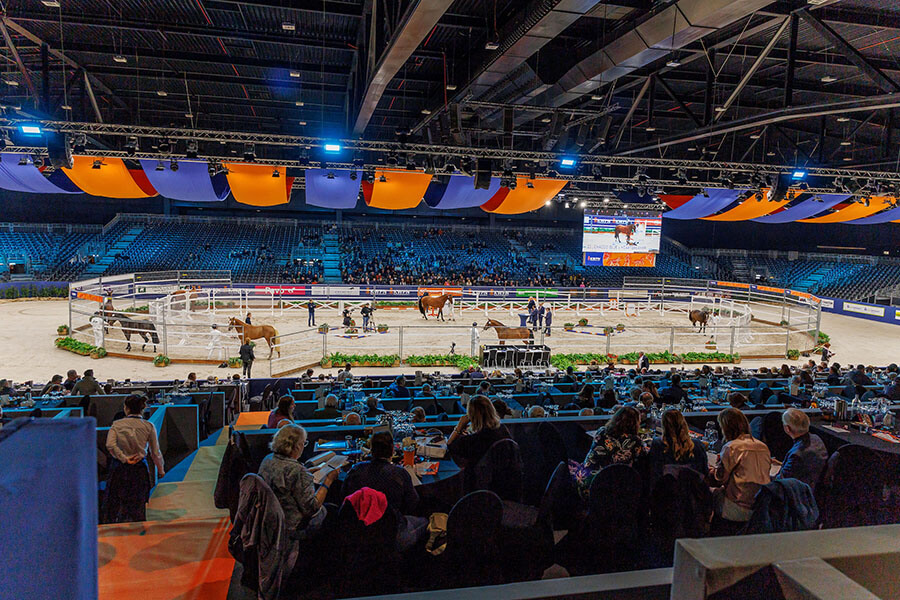
Christopher Hector’s on-the-spot exclusive
Photos – Dirk Caremans and archive
While much of the breeding focus in The Netherlands is now on dressage, in truth, the first love was always jumping and the Dutch breeders are masters when it comes to getting the mix just right when it comes to clearing fences, fast.
This year the KWPN jumping stallion commission licensed 22 young stallions, and it was interesting that of the two stallions who had more than one of their get approved, it was really a case of something old and something new.
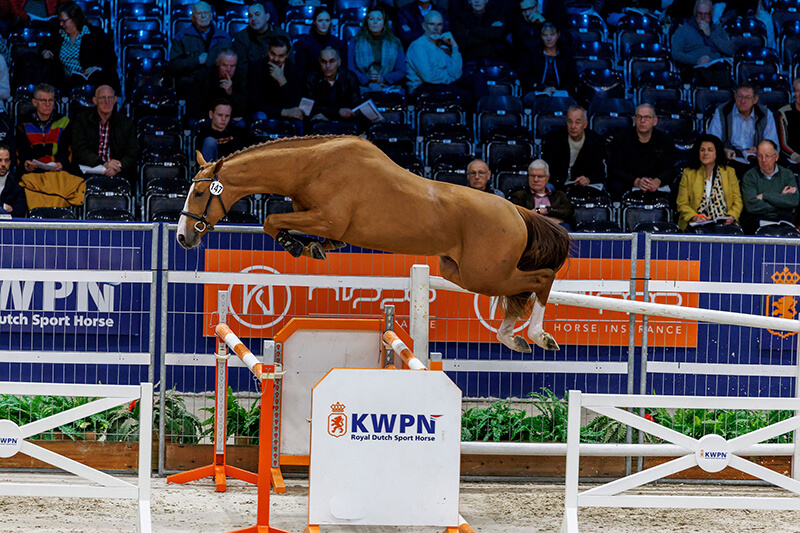
RED BULL no 147, Tangelo/Diamant
Two were by Tangelo van de Zuuthoeve who was born in 1996, and in each case they were out of mares by Diamant de Sémilly who was born in 1991. Tangelo v/d Zuuthoeve combines the blood of two important French sires, Narcos II and the great Thoroughbred, Laudanum, with the most successful lines used at the Zangersheide Stud. His dam, Olympia is out of Racyona Z, a combination of the three founding fathers of Zangersheide: Ramiro, Almé, along with Gotthard, who while never standing at Zangersheide, provided most of the original broodmares at the stud.
Tangelo is the sire of 50 approved sons, and 51 jumpers at 1.60, there’s even two 1.70 competitors, Darry Lou (out of the Nabab de Rêve mare, Venus) and Tobago Z (Whoopie C by Mr Blue).
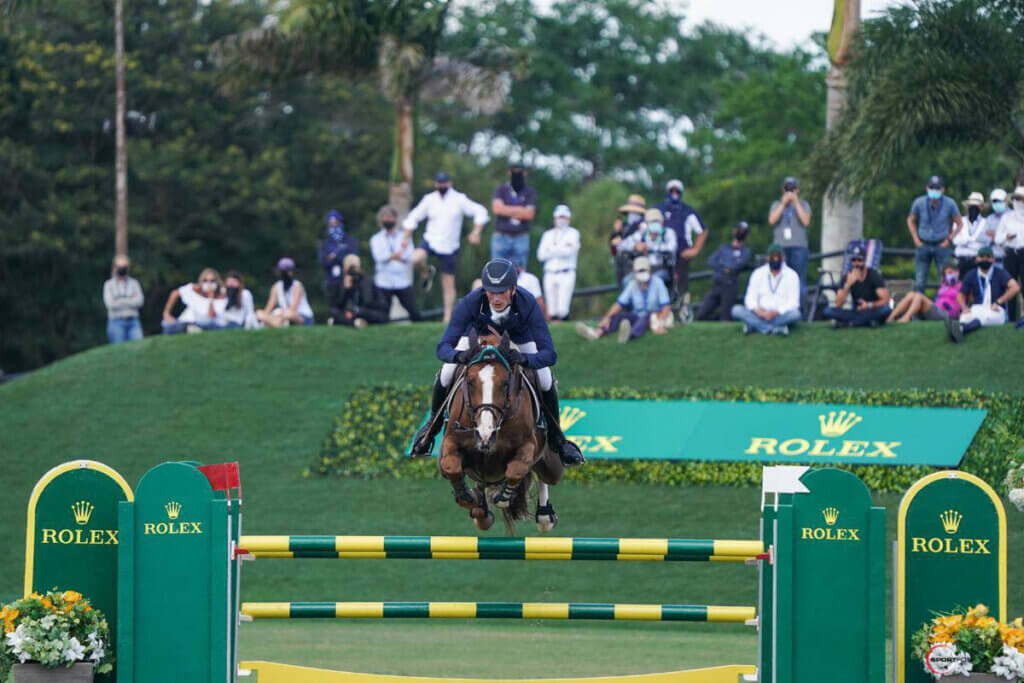
Tobago Z
The something new came in the form of Kasanova de la Pomme who was born in 2010, bred by the French stud, Haras de la Pomme, but he comes from the long established (he started in 1993) and startlingly successful breeding program of Belgian, Joris de Brabander. Kasanova is by Bamako de Muze, a son of the great Darco, out of Joris’ foundation mare, Fragance de Chalus . Kasanova is from the famed mare line of Qerly Chin, his dam is by Malito de Reve, by Cumano. Kasanova is the sire of one 1.65 jumper, and 14 who are competing 1.40/1.45. If one of his twosome gets through the performance test at Ermelo, he will be Kasanova’s first approved son.
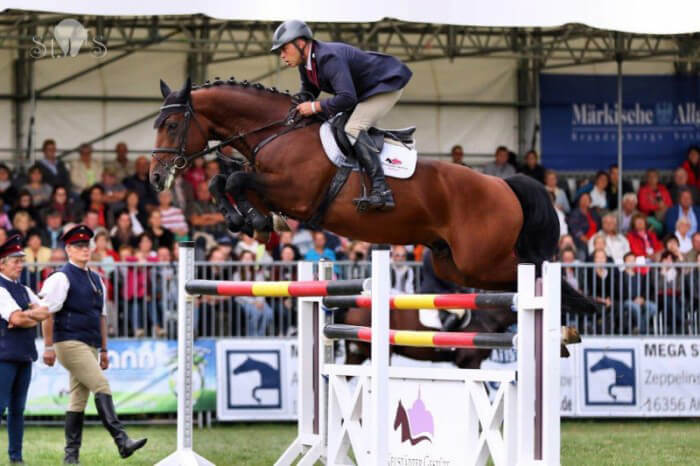
Kasanova de la Pomme
The premium stallions were a nicely varied bunch. Raikkonen LK is by Landino VDL, by Stakkato Gold and out of Sancara VDL, a grand-daughter of Shoraya (born 1976, by Ladykiller xx), one of the three Holsteiner mares Wiepke van Lageweg built his stud on, with the help of Nimmerdor who started the line from Shoraya.
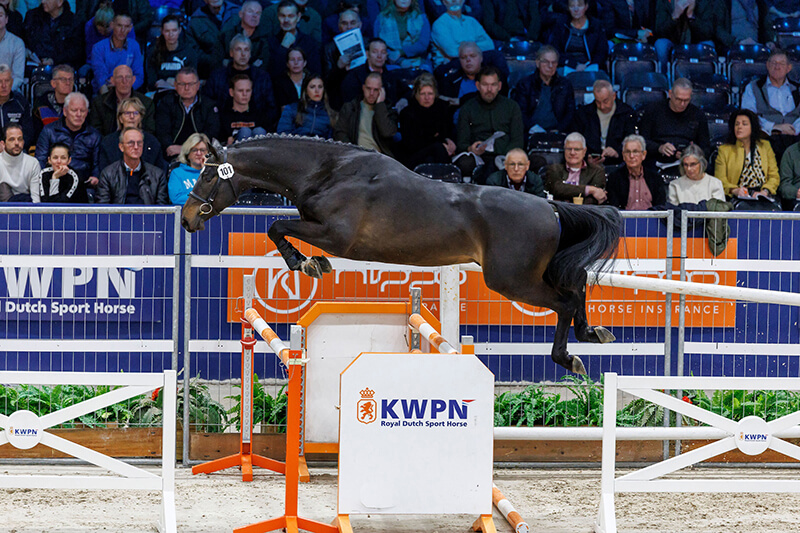
Raikkonen LK Landino/Zirocco
There’s more history on Raikkonen’s dam line. His dam is by the Mr Blue , while he is out of K Amelusiena who is very much a product of one of Holland’s early cutting-edge breeding operations, Stal Roelofs. Sadly, in 2013 after forty years of successful breeding (much of it based on the two foundation stallions, Abgar xx and Joost), the founder Herman Roelofs closed his farm since neither of his children wanted to carry on with horses.
The premium group included R (all the stallions of the year 2024 have to have names beginning with the letter R, I guess the owners just haven’t got around to working out the rest…) by the Comme il Faut son Mattias, out of a Guidam mare; Ramazotti vd Watermolen by United Touch S (1.65), by Untouched (1.60) by Untouchable (1.60, Hors la Loi III / Heartbreaker)out of a mare by the Cardento son, Dakar VDL., and €Ringo Starr by O’Neil van’t Eigenlo (aka Minute Man) by Vigo dArsouilles out of a Montender / Heartbreaker mare.
The stallion show at den Bosch has become an international meeting place, a chance to catch up with others interested in the cutting edge of breeding. One person I always try to meet up with is Arnaud Evain. As the head of France’s largest stallion operation, GFC, his knowledge of where the new blood is coming from is unrivalled. I asked him to tell me about Kasanova de la Pomme…
Why? Because he was the sire of two accepted stallions…
“He’s got good bloodlines for jumping, actually I haven’t seen that many of them. I saw them today and it seems that the breeding they have is what they want in the KWPN studbook. I have seen one or two of them before, but it is not enough to characterise how they jump, next time you ask me I will have a clearer answer.”
But what they offer is basically Joris’ breeding…
“Completely Joris breeding, and that has been very successful, thanks to Querly Chin, but not only Querly Chin, also to the family of Mylord Cathago. He has been the first to produce really good horses from those two lines in Belgium, because Mylord Cathago has produced before, in France, but he has had quite a lot of success combining the two bloodlines. He’s done a clever job.”
The other stallion with two was Tangelo, this is ancient history, a stallion from 1996, he’s older than us…
“Speak for yourself! But I think the Dutch breeding needed the strong back. They had horses with good balance and not such a strong back. Tangelo doesn’t have such a good balance, but a very strong back and I think they wanted to re-import this characteristic. I think if we speak of horses fifty years ago and today, there is a difference, but some horses from twenty years ago, they are still modern and still have something to offer today’s breeding.”
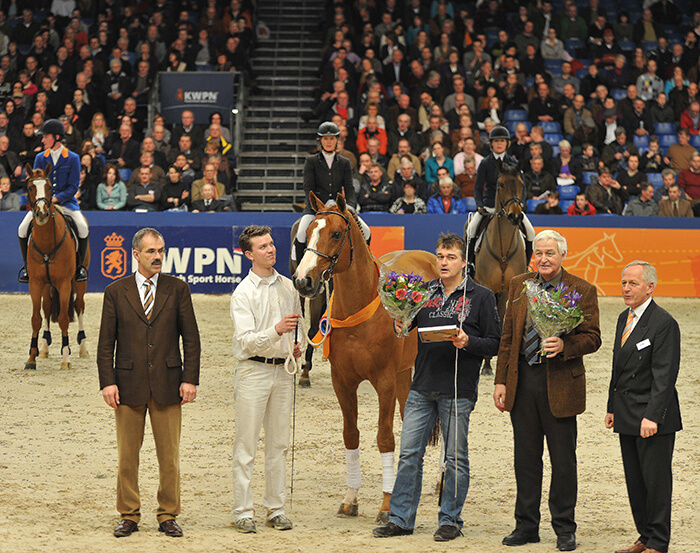
TANGELO honoured with the title Keur, in 2010
“Like you will see tonight with our stallion, Untouchable, he has a very modern quality. He is 23 years old but you will see how good he looks. He has a very modern quality of canter, a useful canter, that’s his strong quality. It’s like Tangelo – he has a strong quality of back, it comes with some inconvenience, not the best balance, but they need this quality in the studbook, and they decided to focus on that, which I think is very clever, very pragmatic, but you and I, we know the Dutch are pragmatic.”
UNTOUCHABLE
I was interested going through the catalogue, the number of horses you find with Quidam de Revel on their pedigree, and yet somebody lost his clone in the middle of Poland, and nobody bothers to go and get it…
“Because they have his progeny, I think Quidam’s children and grand-children are more interesting than Quidam’s clone. The genetic is moving. To me the clone was a wrong way, because if the stallion is not interesting you don’t need his clone and if he is interesting, you use his progeny they bring his quality, plus the other genes they carry.”
“I think the only clone which was useful is Gemini because Gem Twist was a gelding, and a Thoroughbred, so this clone has been useful, but for all the others, as I said, the children and the grand-children are more interesting than the father.”
Why has Quidam himself has such a huge influence?
“Like me, old in the head. In his characteristic he has limitations, a stiff back, not the best mouth, but he is unbelievably careful, and he has the mind of a sporthorse, he wants to work with you for the sport. It’s because he passes his mind that he is so present in the breeding of today.”
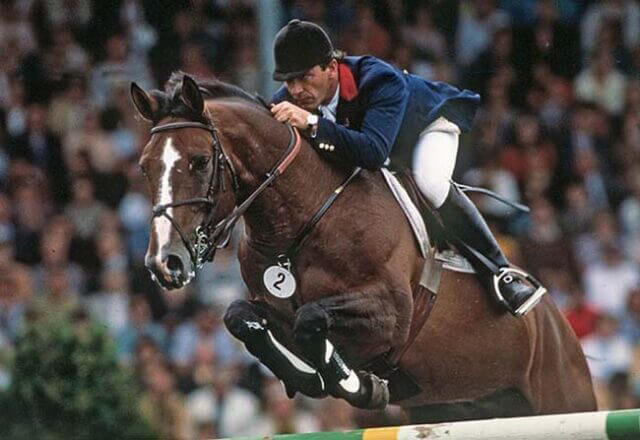
QUIDAM Photo: Peter Llewelyn, Breeding News
“I think in the next interview about showjumpers, we will talk about temperament. There are more and more amateur riders who want to compete, and they need easy horses, naturally quick in their movements so they will not be more than one second slower than the champions. Those people will pay for the horses they can ride and they need to ride easy horses.”
So which stallions will you be looking to, to produce this result?
“In my opinion one very important quality is a natural balance and hind activity in the canter. In our catalogue, I think Untouchable, and his progeny, everyone is talking about his sons. Untouched is a son and United Touch S, a grandson of Untouchable.”
“Also the sire line of Calvaro, which we have in Up to You, brings this natural canter, they are horses which are easy to fix in their balance because they are naturally in a good, useful canter. The quality of the canter, carefulness, of course, the scope comes after.”
“I have many good clients who are happy to jump one forty-five, one fifty, but they want to be competitive. In the Olympics, it is only three horses per team.”
But most people seem to want to breed…
“For the Olympics, but that is a fact which is older than us, it’s always been like that. Of course, we all dream to produce champions, but unrideable champions are not going to go the Olympics. You can easily bring an easy horse up, you can help him to jump five centimetres higher. When you have a difficult horse, with his balance, with his mouth, he needs to be able to jump ten centimetres more than what you ask him. When you are at the Olympics, at the end, you need easy horses because with 1.70 they cannot jump much higher, so they have to be scopey enough, and a good character. So let’s work on the character.”
“I remember at home, we had Barbarian who jumped at the Olympics in Sydney. He was not a typical scopey horse. And our Kraque Boom bois Margot, he was a European champion, but he was really a very good 1.40 horse, the only one who didn’t know he had no scope was him. You can build scope with a horse with a good canter.”
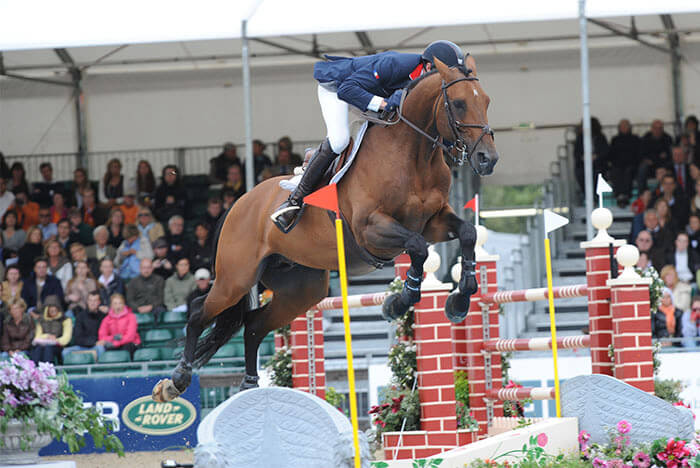
KRAQUE BOOM BOIS MARGOT heading for victory at the European Championships at Windsor
In France is breeding healthy, in other parts of Europe, it’s in trouble…
“We were in the depths in the years 2010, and now in the last four years we have increased the numbers, and as you have noticed, the Selle Français is the number one studbook in the world actually, because of the brain, because of the good character and the desire to do well of the French horses.”
“So I am optimist. I don’t know about the Olympics because of the rule of three horses per team, it’s a real lottery, but for the top sport, I think the French horses will remain stronger for a while.”
Sales are good?
“Embryo sales is decreasing.”
But that’s crazy, people pay euro25,000 for an embryo when they can buy a live foal, just as good, for 5000. This is madness…
“And people are realizing that, so the price of the embryos in the sales, has decreased by about 30%, and I suspect the interest will go down. But our Fences Sales were good, 2022 was excellent, then 23 was a little less than 22, but still the second best year of the century. We are happy with that.”
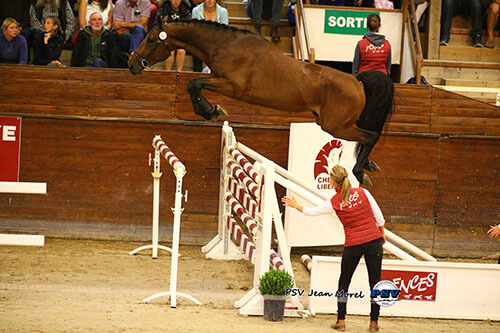
FENCES AUCTION
Egbert Schep is one of Holland’s most successful jumping breeders, and unlike many, he is prepared to take a risk on young stallions, often homebred.
“Three were approved, one by Lacosta AS, that’s the stallion that I bred myself, he goes tonight in the 1.40, seven years old and the other two were from Emerald. I had here an O’Neill that was premium stallion, an El Barrone, and a Grandorado.”
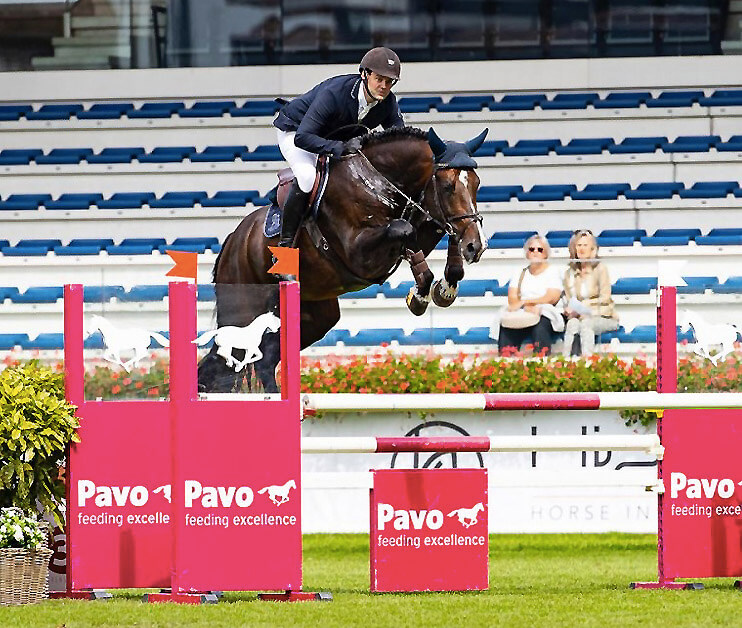
LACOSTA
How many mares are you breeding each year?
“I have 15 older mares that I breed with. Every year we get 50 foals, we flush the good young mares who are in the sport, and take embryos. That works super. We have very good broodmares actually, and that brings success.”
Which do you see as the coming stallions at the moment?
“It’s hard to say. We have good young stallions, the only problem here in Holland – and the whole of Europe – is that the young stallions don’t breed so much. They go to the older Grand Prix stallions, that’s a pity because all these good young stallions, they don’t breed enough, they don’t earn enough, and when they are six, seven, eight, and they jump really good, they are sold abroad.”
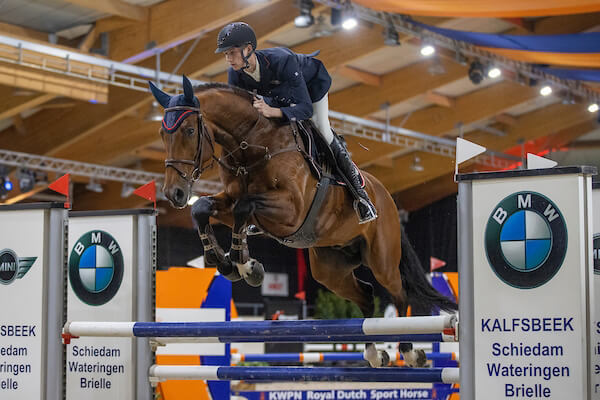
MINDSET
“But I have one stallion that I bred myself, Mindset, he was third in the World Championships in Zangersheide. I sold him to VDL stud and he bred a lot of mares this year, I think about 300, and the offspring we have from him is very promising, that can be a real breeder.”
I see you are a dressage breeder too…
“Yes, we do a little bit of dressage, not so much but it goes well. We have a few very good dressage broodmares.”
Which stallions do you like on the dressage scene?
“You have a little bit more choice than with the jumpers. I’m a big fan of the offspring of Vitalis, we had some very good ones by Vitalis from our own breeding, for the rest we always look for a new talent, for new blood.”
Do you use the same ‘eye’ for jumping and dressage horses?
“You have to have a different eye for each, the dressage horse is quite another type from the jumper. The dressage horse has to be more uphill with a vertical neck, and a jumper has to be also uphill in his body but not in his neck. What is actually the same and very important for a dressage horses and for a jumper, is that they have real muscles on the back, that’s very important.”
VDL remains a major player on the Dutch breeding scene, and Wiebe Yde van der Lageweg was well pleased with the success of their young stallions:
“The son of Landino, it’s from the first year of the Landino foals, he had three at the show and two approved. One out of a Zirocco mare, is a very modern type of sport horse, good mover, correct and jumps really good.”
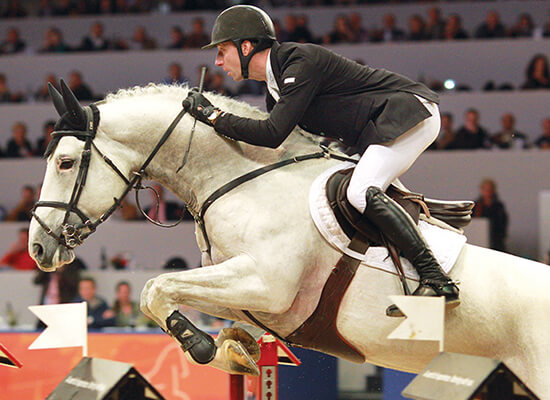
ZIROCCO
Your father found Zirocco in France…
“When Mr Blue died, we called Arnaud Evain, looking for a son. My father saw four or five, but was determined to have Zirocco, he was a two year old, skinny no muscles, rough. But when he saw him in the paddock, trot and canter, he said that’s the one I want to have.”
It’s amazing, the pedigree goes back to Shoraya, the Ladykiller mare that was one of the ones that started your stud…
“She was one of the first we bought, and from this mare we have so many good horses, mares, stallions and sporthorses. There is so much quality in the line of that family, you can’t go wrong with so much quality.”
Which way is your breeding going, I was talking to Arnaud earlier, and he said he was more breeding horses with a good brain for the 1.40 amateur rider…
“That’s not new, we have been breeding for many years in that direction, because ten, fifteen years ago, you could see a new generation that rode different, so you needed a different kind of horse. The competition has been changing these last ten, fifteen years, so you know you have to change a little bit your breeding program to make a different kind of horse. You cannot make the old-fashioned horse from twenty years ago any more. But we started doing this some time ago because to change a horse you have to be working in the second or third generation. You have to think in generations.”
And is business still good for you, in Germany there are a lot of breeders saying that they are in trouble…
“The average number of breedings in Europe is down, Sweden, Germany, Holland, Belgium – but we are still getting the same number of mares. It also depends on the stallions you have, if you are breeding good for competition sport, then you keep the mares. There are many older breeders that have stopped and there are not many younger ones coming into breeding, that’s a worry for the coming fifty years.”
You need to breed some more children…
“I have two children, my two brothers also have two children. My oldest is seventeen, my youngest fourteen, it looks like they are interested, they are helping with the farm, so I hope we have a new generation to come.”
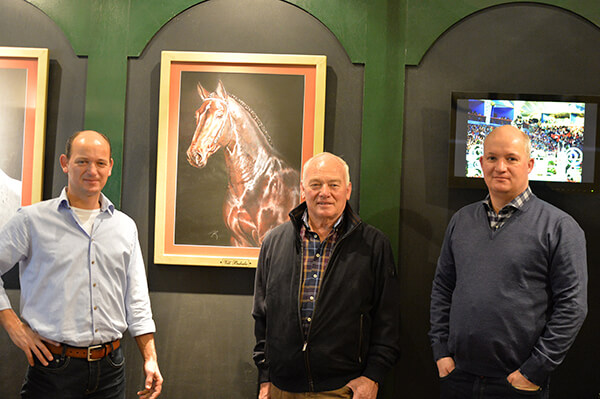
There’s generations to come: Janko, Weipke and Wiebe Yde…
The Dutch have long been smart enough to include riders and trainers on their selection panels, and this year, Olympic showjumper, Wout-Jan van der Schans headed up the jumping stallions panel.
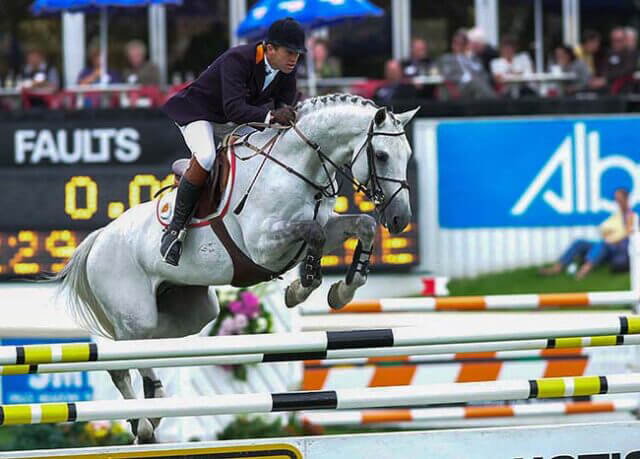
CORLAND and Wout-Jan. Photo: Peter Llewelyn, Breeding News
I asked Wout-Jan, looking at the stallions you saw today, where do you think Dutch jumping breeding is sitting?
“I think we had some really good stallions, modern horses, the stallions we need for the future in the sport. We need horses that are going by themselves, they want to jump by themselves, they have a pleasure in jumping, because everybody is watching and if they think a horse is not happy in what he is doing, in ten, twenty years you cannot ride anymore. We need horses that love the sport and I think that’s what we try to select the stallions on. You saw the horses, they all want to jump and they jump easy.”
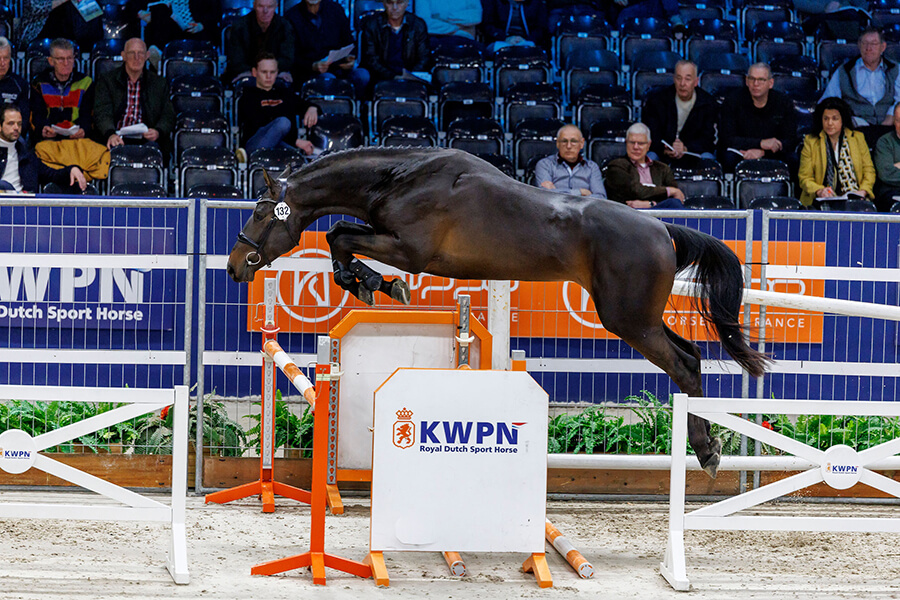
RINGO STARR
You didn’t mind if they were tall like Ringo Starr..
“The O’Neil, that’s a really big horse, 176cm but you couldn’t see it, he was moving really easy, like a small horse, with a lot of blood. That’s a very good example of what we need in the future, big horses with a lot of blood.”
I was looking at the stallions you accepted, and they were mainly from stallions that we have had for quite a long time, not so many new stallions… We had two from Tangelo born 1996, and both out of mares by Diamant, born in 1991, that’s over 20 years ago…
“It says something of the sport, that there are still very good horses coming from Diamant and Tangelo, from Kannan, and they still give a lot of blood. Those horses are very modern horses actually. When Diamant started there were not so many mares that had done big sport, and now you see a lot of breeding mares jumping on a big level, and when you bring that with Tangelo, or Kannan, for sure you get better horses.”
Diamant has bred superstars, no question, but Tangelo…
“Tangelo is difficult, of course you have some horses that are really good, but you need blood, and that why now, with mares with a lot of blood we still try to get a good Tangelo. But you see of the sons of Tangelo, we don’t have so many in the KWPN so we are looking for the good ones.”
Two stallions you accepted were by Kasanova de la Pomme…
“That’s a stallion that jumped really well in Belgium, in the Belgian team, and I think this is the first time we have two sons of him here. The grey one was jumping both times really well, the other one, the brown, is a beautiful horse to watch. At the pre-selection in Ermelo, he was really spectacular, today he was a little bit less in his jumping, but still good. I think they are two promising stallions, worth a try in the saddle test. The two we have here were really quality horses, if he brings a lot of them, they can be happy with him, but I don’t know because I think this is the first or second year, he brings some. I haven’t seen the ones in Belgium.”
Kasanova is very much the creation of the breeding program of Joris de Brabander…
“Of course, and the stallion himself is a really good jumper, a fast horse and a light horse, he’s worth a try.”
Talking about stallions from the past, in the majority of your selections, you can find one cross of Quidam de Revel, sometimes two crosses…
“In his time, Quidam de Revel was far ahead, with his sons he did not bring so much, but on the motherline he bred a lot. We still have in Holland some very good mothers with Quidam in them, and it is good to have stallions from them.”
Do you think it is still a problem, that the mare owners want to go to the established older stallions, and the younger stallions don’t get a chance?
“That is not only a problem in Holland, that is why we try to show the people what we need for the future, and you can only bring more blood and more light jumping, in your future horses, if you use the sons of those good stallions. That’s what we try to create for the people. We say, okay, the father was really good, but the son because of his blood and his light going, he could be maybe better for you in the future.”
That’s what breeding is supposed to be about…
“But at the moment, a lot of people are breeding for the auctions, and that’s what we have to show people that they can do both, the sport and the auctions.”
Have you moved from being a rider to being a breeder?
“No, I am still a rider, but I always did a little bit of breeding. We have always tried to get more sport people into the selection of the stallions because that’s when you live for the sport, and breeding is breeding for the sport.”
ends
